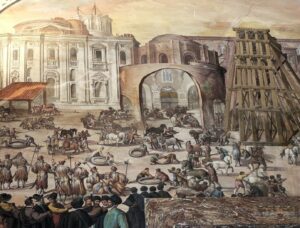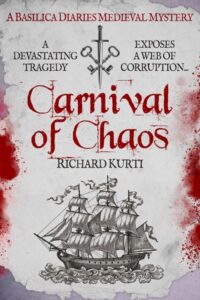Congratulations to Richard Kurti, whose absorbing medieval adventure, Carnival of Chaos, is out now!
Carnival of Chaos is the fourth book in the Basilica Diaries Medieval Mysteries series: historical thrillers set in fifteenth-century Rome and featuring a brother and sister investigative duo.
An abandoned ship is drifting in the mouth of the Tiber and a horrific discovery is found inside.
Nearly three-hundred men were packed together in the hold. All of them are dead.
They were migrant workers shipped over from North Africa, cheap labour to cut the cost of building St Peter’s Basilica, and all have died in the most horrendous circumstances.
The Vatican is desperate to distance itself from this atrocity. The guilty contractor must be found and punished, and the entire illegal trade in people must be stamped out.
The Pope charges his Head of Security, Domenico Falchoni with conducting a full investigation.
Domenico turns to his scholar sister Cristina for help and together they delve into the grudges and rivalries of the old dynastic families who are competing for building contracts for the great basilica.
Cristina and Domenico discover that dirty tricks extend across all aspects of the great construction and corruption is rife. So it is not easy to find out who is responsible for the horrific deaths of the migrant workers.
Can they protect other workers from untimely deaths? Will they expose those responsible?
Or will digging into the dark world of human trafficking put their own lives at risk…?
A few weeks ago, I was standing outside St Peter’s Basilica in Rome, gazing at the ancient Egyptian obelisk that sits in the middle of the square. (It’s also on the front cover of Omens of Death — the first book in The Basilica Diaries series.)

A fresco in the Vatican depicting preparations for the erection of the obelisk in front of St Peter’s Basilica. Photograph taken by Richard Kurti.
The guide who was showing me round said, “There’s an interesting story about this obelisk. When Moses was a young man, he was educated in Heliopolis (modern Cairo), where this obelisk originally stood. As he hurried back and forth to school, Moses would have seen this very stone every day. Even then it was a thousand years old. He would have walked past it, used it as a meeting point for friends, maybe even sat in its shade.
“Now, cut forward across time. The Romans have stolen the obelisk and brought it to Italy, where the Emperor Caligula ordered it to be set up at the Circus of Nero just outside the city walls. And that is the same place where St Peter was executed. Which means the very last thing St Peter saw before he died would have been this obelisk. And now you are gazing at the exact same stone.”
I could feel my brain jolt. Moses, Caligula, St Peter and myself, all connected across 4,500 years by a single object. These were no longer remote characters from the pages of the Bible — if I reached out my hand, I could touch them through this granite obelisk.
 What the guide did was a brilliant demonstration of the power of narrative. He could have bombarded me with facts and figures about the height and weight of the obelisk, about where the stone was quarried and when it was carved, and how it was moved from the Circus of Nero to its current site and erected in a single day.
What the guide did was a brilliant demonstration of the power of narrative. He could have bombarded me with facts and figures about the height and weight of the obelisk, about where the stone was quarried and when it was carved, and how it was moved from the Circus of Nero to its current site and erected in a single day.
But he didn’t, because he knew that those facts would have gone in and out of my mind in seconds. Instead, he told a story that organised the truth in such a way that it connected me to the distant past.
That’s what I’ve been attempting to do on every page of The Basilica Diaries historical thrillers. I have spent countless hours researching the novels, but rather than bombard the reader with details, I have tried to organise the truth into narratives that will resonate with the modern world whilst also transporting us back across the centuries.
I hope you enjoy the latest adventure in the series, Carnival of Chaos, which will be published in April.

